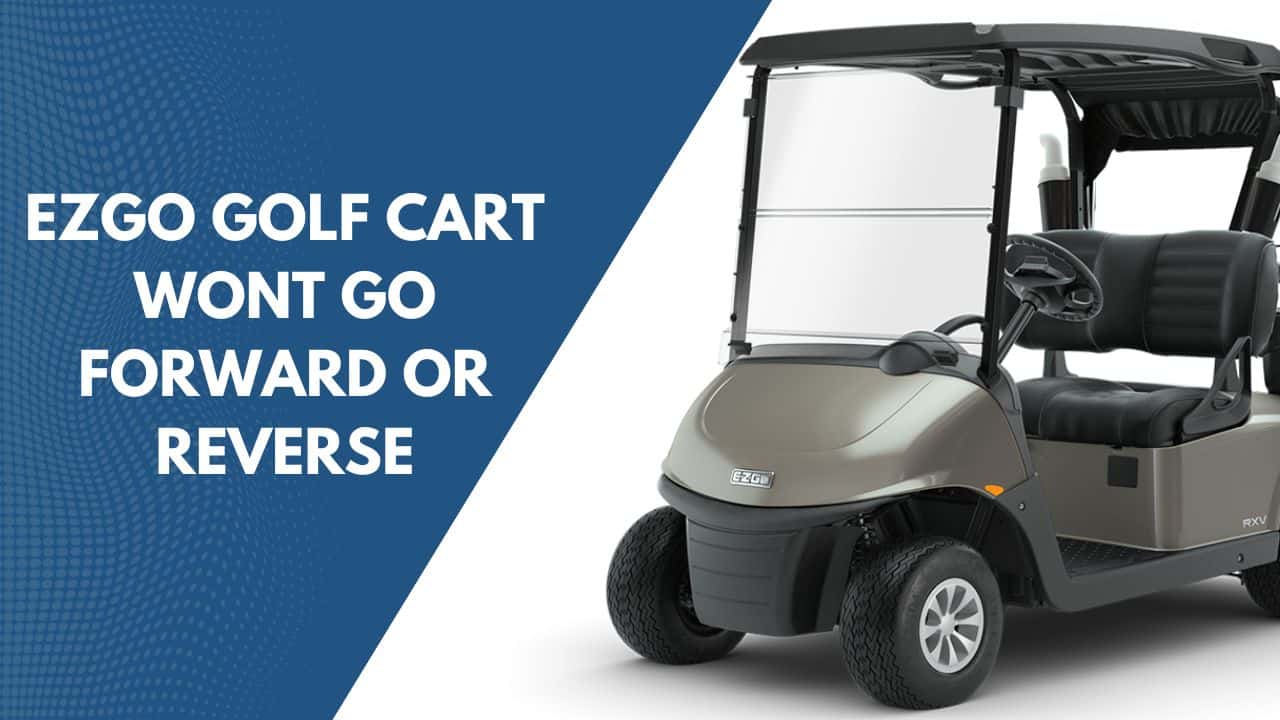EZGO Golf Cart Won’t Go Forward or Reverse: 12 Causes And Solutions

There can be moments when your EZGO golf cart unexpectedly fails to move and simply won’t go, whether it’s forward or in reverse. Suddenly, your leisurely round is halted, and you find yourself stranded, potentially far from the next hole or the clubhouse.
This situation can be attributed to various factors, ranging from the smallest components, like a finicky microswitch, to more significant issues, like a dead battery or troublesome solenoid.
I. List of 12 Common Reasons Why EZGO Golf Cart Won’t Go Forward or Reverse
We have listed all the potential causes, their practical solutions, and preventions for your EZGO golf cart to not go forward or reverse.
- Battery-Related Challenges
- Motor and Control System Problems
- Microswitch and Sensor Concerns
- Defective Ignition Switch
- Solenoid Issues
- Electrical Wiring and Connection Problems
- Fuel System Challenges
- Dirty Air Filter
- Spark Plug Troubles
- Brake and Shifting Complications
- Fuse Related Issues
- Problem with the Accelerator
1. Battery-Related Challenges
EZGO golf carts, whether gas-powered or electric golf carts, rely on batteries to get it moving. However, batteries in EZGO golf carts can encounter their fair share of challenges.
Golf cart batteries are an essential component to power electric golf carts. To ensure you don’t find yourself stranded, these batteries must consistently deliver substantial current over extended periods, guaranteeing a continuous and reliable power source for your golf cart.
Causes
- Inadequate Battery Charge: When the battery charge falls below the required level, the golf cart may not have enough power to operate. This often happens due to neglecting to recharge the battery properly or overusing the cart without regular recharging.
- Battery Ageing: Over time, batteries naturally degrade. As a battery ages, it may lose its capacity to hold a charge effectively.
- Incorrect Battery Type: Using the wrong type of battery can cause compatibility problems. Electric and gasoline-powered carts require different types of golf cart batteries due to differences in voltage and charging systems.
- Electrical Connection Issues: Loose, damaged, or corroded electrical connections can interrupt the flow of electricity, leading to various electrical problems.
Solution and Prevention
- If your golf cart’s battery charge falls below 12.7 volts, recharge it using a suitable charger. If the battery is old or no longer holds a charge, replace it.
- Regularly clean the battery terminals and apply a battery terminal protectant or grease to avoid future corrosion.
- Examine the negative battery cable and positive battery cable for signs of damage, such as fraying or exposed wires. Replace damaged cables as needed.
- Verify that you have the correct battery type installed in your golf cart, matching either electric or gasoline power systems.
2. Motor and Control System Problems
Your golf cart’s motor and control system work together for the cart to move forward and in reverse with precision and control. When these components encounter issues, it can disrupt your smooth ride and lead to problems.
Causes
- Malfunctioning controller: A faulty EZGO golf cart controller can disrupt the communication between the battery, motor, and other electrical components.
- Wear and Tear: Over time, the golf cart motor and control system components can experience natural wear and tear, affecting their efficiency and performance.
- Electrical Issues: Problems, such as short circuits or damaged wiring, can disrupt the proper functioning of the control system, leading to motor issues.
- Physical Damage: Damage to the motor or control system components, whether from accidents or environmental factors, can directly impact their functionality.
Solution and Prevention
- Conduct regular inspections of the motor and control system components to identify signs of wear, loose connections, or damage.
- Follow the maintenance schedule of the EZGO, which includes routine service tasks for the motor and control system.
- Operate your golf cart within recommended weight limits and avoid extreme conditions, such as steep inclines, excessive loads, or rough terrain.
- Address any identified issues by repairing or replacing worn or damaged motor and control system components.
- Seek the assistance of a professional technician if required.
3. Microswitch and Sensor Concerns
Another reason for your EZGO golf cart to not move forward or reverse can be the microswitch and sensor concerns, which control the golf cart’s forward and reverse functionality.
Causes
- Faulty Microswitch: A faulty microswitch can disrupt signal transmission to the controller, leading to loss of cart movement control.
- Stuck Microswitch: A stuck microswitch can disrupt signals to the controller, preventing the cart from moving.
Solution and Prevention
- Inspect the Run-Tow switch and the Forward-Reverse switch for proper operation.
- Ensure they are not stuck in a midway position and gently move them to their intended positions if needed.
- Identify if there is any damaged or worn-out microswitch and replace it with a new one.
- Examine the key switch to ensure its tab is securely fastened. If it’s loose, tighten it to maintain a reliable electrical connection.
4. Defective Ignition Switch
The ignition switch bridges the gap between the starter and the battery,allowing the golf cart to start.. However, when this switch has issues, it can disrupt the cart’s ability to start and operate smoothly.
Causes
- Defective Ignition Switch: A defective ignition switch can result from wear and tear over time or manufacturing flaws. It may fail to make proper electrical contact, preventing the cart from starting.
- Electrical Connection Issues: Poor electrical connections at the ignition switch terminals or wires can restrict the flow of electricity, causing intermittent or complete failure of the ignition switch.
Solution and Prevention
- Handle the ignition switch with care and refrain from applying excessive force when turning the key or switch. Be gentle with the ignition switch when starting or stopping the golf cart.
- If you notice any damage or signs of wear on the ignition switch, consider replacing it with a new switch.
- In case of complex ignition wiring issues, consider seeking assistance from a professional golf cart technician.
5. Solenoid Issues
A solenoid is responsible for directing power from the battery to the parts that make your cart move. But when the solenoid has problems, it can disrupt the normal power supply, leading to a loss of mobility in your cart.
Causes
- Solenoid Issues: A solenoid can develop defects due to manufacturing issues or internal wear over time, resulting in its failure to function properly.
- Extreme Weather Impact: Exposure to extreme weather conditions, such as severe cold, heat, or moisture, can negatively impact the solenoid’s functionality.
- Physical Damage: Damage, such as dents or fractures, can impair the solenoid’s ability to function correctly.
Solution and Prevention
- Incorporate routine inspections of the solenoid into your regular golf cart maintenance schedule. Examine it for signs of wear, corrosion, or loose connections.
- Assess the solenoid’s functionality by temporarily bypassing it. If the cart operates in this test, it indicates that the solenoid may be faulty, and you should consider replacing it.
Note: If you need to bypass a solenoid in a golf cart, connect a jumper cable directly from the battery’s positive terminal to the golf cart’s motor, effectively circumventing the solenoid’s function.
6. Electrical Wiring and Connection Problems
Electrical wiring and connections are an essential part of a golf cart. Often we ignore their maintenance, creating problems with our golf cart movement.
Causes
- Worn Insulation and Frays: When insulation deteriorates or becomes frayed, it can lead to exposure to external elements, resulting in disruptions in the electrical circuit.
- Loose Connections: Connections that are not securely fastened can lead to electrical resistance or disconnection.
- Short Circuits: Short circuits can cause electrical components to malfunction or become damaged due to the sudden surge in current. They can also pose a fire hazard if left unaddressed.
- Broken Shift Cable: When the shift cable breaks or becomes damaged, it can lead to a disruption in the electrical connections needed for effective gear shifting. This, in turn, can affect the cart’s ability to shift between forward and reverse gears smoothly, resulting in operational issues.
Solution and Prevention
- Regularly clean your golf cart to remove debris and prevent the buildup of moisture. Additionally, take measures to keep rodents away from your cart’s electrical components.
- Incorporate routine inspections of the electrical wiring and connections in your golf cart as part of your maintenance regimen.
- If you discover damaged or worn-out electrical components during inspections, take immediate action to repair or replace them with new parts.
7. Fuel System Challenges
The fuel system of your vehicle is another aspect that can be the reason for your golf cart to not move forward or reverse.
Causes
- Malfunctioning Fuel Tank Indicator: A malfunctioning fuel tank indicator can inaccurately measure fuel levels, misleading the cart operator about refueling needs and potentially causing the cart to stall.
- Contaminated Fuel: Fuel contamination due to dirt, debris, or water can affect the fuel system’s performance.
- Clogged Fuel Filters: Over time, fuel filters can become clogged, restricting the flow of fuel to the engine.
Solution and Prevention
- Verify the accuracy of the fuel tank indicator and replace it if it’s faulty.
- Ensure that you use clean, uncontaminated fuel. Proper fuel storage and maintenance can prevent contamination.
- Follow a maintenance schedule to replace fuel filters as recommended by the manufacturer or when signs of clogging appear.
8. Dirty Air Filter
For your golf cart to operate smoothly, it relies on a blend of fuel and air. The air filter is instrumental in this process, safeguarding the engine from harmful dirt and debris by filtering out the impurities from the incoming air.
Causes
- Clogged air filter: A clogged air filter in your golf cart can restrict airflow to the engine, disrupting the air-fuel mixture and leading to decreased power output and potential performance issues.
Solution and Prevention
- Incorporate routine cleaning of the air filter into your golf cart maintenance schedule. Remove accumulated dirt and debris to restore optimal airflow.
- Follow the user’s guidelines regarding air filter maintenance and cleaning intervals.
- Consider replacing the filter if it is damaged, deteriorated, or cannot be effectively cleaned.
9. Spark Plug Troubles
The Spark Plug in a golf cart is a critical component that initiates the combustion process, drives the engine, and influences both performance and emissions.
Proper maintenance of spark plugs is essential to ensure the golf cart runs smoothly and efficiently.
Causes
- Worn-out Plugs: Overtime and extended use can wear out spark plugs, leading to the deterioration of their electrodes and insulators.
- Loose Wiring: Loose or improperly connected wiring to the spark plug can disrupt the electrical circuit, affecting the spark plug’s ability to generate a spark.
- Corrosion and Deposits: Accumulation of corrosion, carbon deposits, or other contaminants on the spark plug’s electrodes can hinder its ability to generate a strong spark.
Solution and Prevention
- Regularly remove and inspect the spark plugs for signs of wear, damage, or fouling.
- Clean spark plugs using appropriate cleaning methods and materials. If cleaning is no longer effective or if the spark plugs show signs of severe wear, replace them with new ones.
- When replacing spark plugs, ensure you purchase the correct replacement plugs recommended for your golf cart model. Additionally, set the spark plug gap according to manufacturer specifications.
10. Brake and Shifting Complications
The functionality of the brake system in an electric golf cart is crucial to ensure safe operation, especially when navigating steep slopes or crowded surroundings.
Causes
- Locked-Up Brake: When a brake becomes locked, it can lead to uneven braking force, making it challenging to control the golf cart’s speed or bring it to a stop.
- Brakes Seizing Up: When brakes seize up, they may not release or engage correctly, leading to erratic braking behavior, increased wear on the brake components, and potential overheating of the brake system.
Solution and Prevention
- Replace the worn or damaged brake components, such as brake pads, calipers, drums, or cables.
- Regular inspection and maintenance of the brake system can help identify components that are prone to wear or corrosion.
11. Fuse-Related Issues
Fuses serve as safety devices designed to protect electrical circuits from excessive currents. In an EZGO golf cart, the disruption of various electrical systems and accessories can occur if there is something wrong with the fuse.
Causes
- Blown Fuses: Blown fuses occur when there is an excessive current in an electrical circuit. This can happen due to overloads or short circuits. When a fuse blows, it interrupts the electrical flow, protecting the system from damage.
- Tripped Circuit Breaker: A tripped circuit breaker, often caused by an electrical overload or short circuit, interrupts power flow and can disrupt the operation of EZGO golf cart’s electrical systems.
Solution and Prevention
- Avoid Overloading the Electrical System: To maintain your EZGO golf cart’s electrical system, avoid overloading by not using too many electrical accessories at once and only using devices designed for your cart.
- Replace Blown Fuses: When a fuse blows, it’s crucial to replace it promptly. Always replace blown fuses with ones of the correct rating to ensure proper circuit protection and consistent electrical operation in your golf cart.
12. Problem with the Accelerator
The accelerator pedal is a crucial component in controlling the speed of your golf cart. It regulates the flow of gas to the engine, allowing you to manage your cart’s speed effectively.
When accelerator issues arise in a golf cart, they can significantly disrupt your otherwise smooth ride on the fairway.
Causes
- Stuck or Damaged Accelerator Pedal: If an accelerator pedal is stuck or damaged due to cracks, breaks, or wear can impede its normal operation. A damaged pedal may not return to its resting position or may struggle to control the throttle effectively, leading to speed control problems.
- Wiring Issues: Electrical wiring problems can disrupt the communication between the accelerator pedal and the engine’s throttle control. Wiring issues, such as frayed wires, loose connections, or shorts, can interfere with the transmission of signals.
- Stretched Accelerator Cable: A damaged or stretched accelerator cable can disrupt the transmission of pedal movement to the carburetor. When the cable doesn’t function as intended, the carburetor cannot adjust the air and fuel mixture appropriately, resulting in speed control problems.
Solution and Prevention
- Avoid Excessive Force: It’s essential to handle the accelerator pedal with care and avoid applying excessive force when pressing down on it. Excessive force can lead to damage or accelerated wear of the pedal, affecting its ability to control the throttle accurately.
- Check If Carburetor Operates Properly: In cases where speed control problems persist, it’s advisable to check the carburetor’s functionality. Ensure that the carburetor is operating correctly and smoothly adjusting the air-fuel mixture as you press the accelerator.
- Replace If Damaged: If the accelerator pedal is damaged and fails to control the throttle effectively, it’s crucial to replace it promptly.
Conclusion
By identifying the root causes and following the appropriate solutions and preventive measures, you can keep your golf cart running smoothly.
Remember that regular maintenance and thorough inspections are key to preventing these issues and ensuring a hassle-free golf cart experience. Always exercise caution and prioritize safety when performing any maintenance or repairs on your golf cart.
FAQs
1. What to do when your EZGO Golf Cart Engine Stop When Shifting Into Gear?
If your EZGO Golf Cart fails when you shift gears, here’s what to do: First, check and adjust the accelerator cable.
If that doesn’t solve the issue, adjust the idle speed using the carburetor’s idle adjustment screw.
2. What to do when your My EZGO Golf Cart doesn’t Go In Reverse?
If your EZGO Golf Cart isn’t moving in reverse, it might be due to the reverse warning buzzer being disconnected.
To address this issue, reconnect the reverse warning buzzer. This should restore the reverse functionality to your golf cart, allowing it to move in reverse as intended.
3. What to do when your EZGO goes in reverse but not forward?
If your EZGO gas golf cart goes in reverse but not forward, it could be attributed to several issues. Firstly, inspect the Forward and Reverse contacts to ensure they are in good condition and free from problems like shorts.
Additionally, check for faulty high amperage cables and ensure that the motor wires are correctly connected and haven’t been swapped.
4. What to do when your EZGO goes fast when in reverse?
If your EZGO golf cart goes too fast in reverse, it could be due to swapped motor wires, a mismatched Forward/Reverse switch, or a short circuit in the wiring.
To address this issue, consider swapping motor wires, checking for a half-speed reverse lead in the controller, or swapping leads on the Forward/Reverse switch.
5. How do you test forward and reverse switches?
To test the forward and reverse switches in your golf cart, first check all electrical connections for security.
Then, use a multimeter to measure the voltage across the circuit board, ensuring the foot brake is engaged, the key is inserted, and the accelerator pedal is pressed to charge the solenoid and verify the switch’s operation.
6. How Do I Reset My EZGO Golf Cart Controller?
To reset the controller on your EZGO golf cart, look for the reset button, which is generally situated on the controller itself. Consult your golf cart’s manual for specific instructions on using the reset button.
This procedure is effective in resolving performance issues and restoring your EZGO golf cart’s optimal functionality.








